|
Around the World and
Then
Some in a Coffee Mug
by Bob Brooke
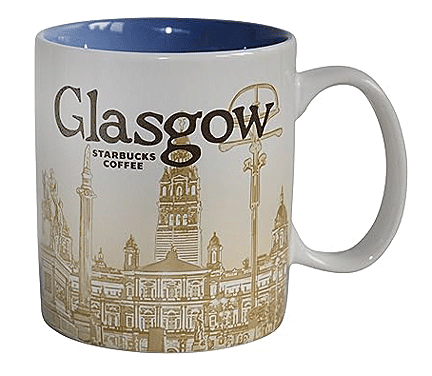 Promotional
merchandise seems to be everywhere, from toy trucks to stuffed animals
to coffee mugs. Collecting these has become a passion for some people
and with the advent of online auctions and other retails sites,
collectors can find just about any promotional collectible on the
market. And that includes Starbucks coffee mugs in seemingly endless
varieties. Promotional
merchandise seems to be everywhere, from toy trucks to stuffed animals
to coffee mugs. Collecting these has become a passion for some people
and with the advent of online auctions and other retails sites,
collectors can find just about any promotional collectible on the
market. And that includes Starbucks coffee mugs in seemingly endless
varieties.
Founded on 30th March 1971, Starbucks has grown to become an iconic
coffee chain that has fans in every corner of the world. The company’s
success can be attributed to its high-quality coffee, a high level of
hospitality, great branding, and its great merchandise.
Among the company’s merchandise are the Starbucks mugs. These mugs have
an expansive collector’s craze around them. People have been known to
collect different thematic Starbucks mugs, from country-themed,
Christmas specials and coffee-producing places to Disney specials.
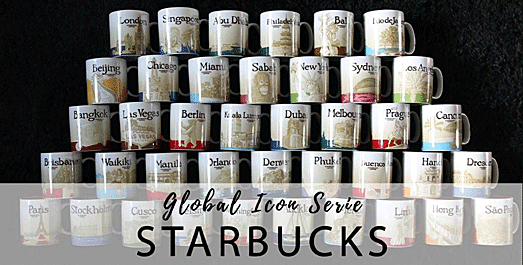
While the market for many promotional collectibles tends to go up and
down like a rollercoaster, the market for Starbucks mugs, on the other
hand, seems to skyrocketing to the stratosphere. One of the reasons for
this is that Starbucks limits the number of each mug it sells. Instead
of just one series, like Hess Toy Trucks, produced in such abundance
that they flooded the market, leaving some worth less than customers
paid for them, Starbucks has produced a number of different mug series,
so collectors have their choice of what to collect.
The First Series Appear
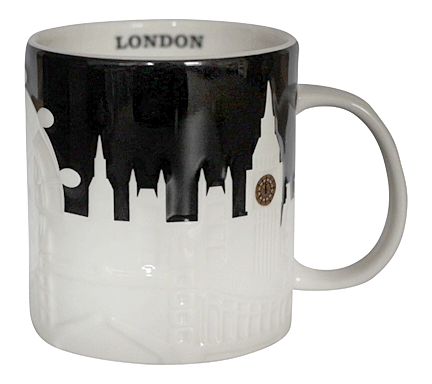 Starbucks
introduced its first city collection in 1995. and was the ‘Icon Series’
followed by the ‘Collage Series’ and then the ‘Skyline Series’. Now
there is the jumbo-sized ‘City Mugs Series’. Starbucks
introduced its first city collection in 1995. and was the ‘Icon Series’
followed by the ‘Collage Series’ and then the ‘Skyline Series’. Now
there is the jumbo-sized ‘City Mugs Series’.
But the first cups to collect were already available in 1994. Starbucks
released the Global Icon series in 2008, releasing 44f7 different mugs.
It gave coffee lovers and avid travelers a unique way to commemorate
their travels. Tens of thousands quickly realized the series was a well
designed, conversation piece, plus a way to recall cherished memories.
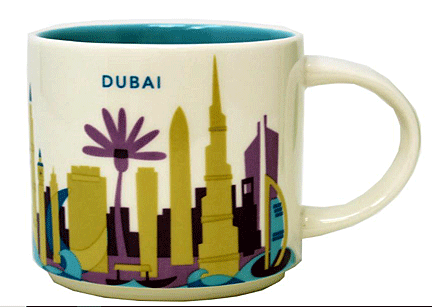 Then
Starbucks decided to discontinue the Global Icon series, replacing it
with a colorful and cartoonish "You Are Here" series. But the European
and Asian markets hung on to the Global Icon series past the 2012
introduction of the You Are Here mugs. Sadly, the Global Icon mugs began
to disappear to the shagrin of collectors. The You Are Here mugs also
had a different form, with a shallower, wider bowl that cools coffee
more rapidly. Then
Starbucks decided to discontinue the Global Icon series, replacing it
with a colorful and cartoonish "You Are Here" series. But the European
and Asian markets hung on to the Global Icon series past the 2012
introduction of the You Are Here mugs. Sadly, the Global Icon mugs began
to disappear to the shagrin of collectors. The You Are Here mugs also
had a different form, with a shallower, wider bowl that cools coffee
more rapidly.
The Global Icon series alone contains 420 different
cups. In addition, there are country cups. China has the most cups with
59, followed by the United States with 49, then Germany with 38, and
Mexico with 26.
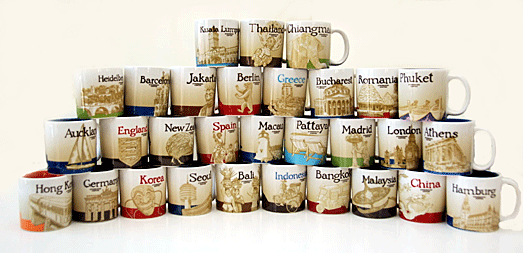
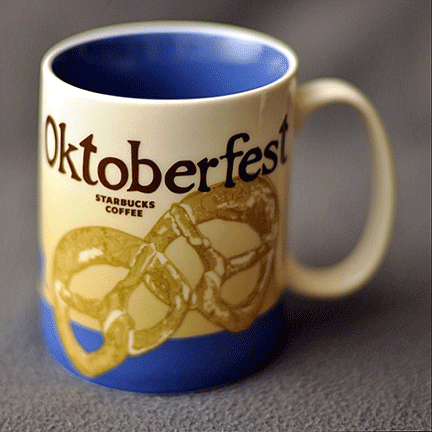 Besides
the city and country cups, Starbucks issued a series of special cups to
celebrate popular events such as Oktoberfest. There are also cups for
states in the United States. It seems just about everywhere there’s a
Starbucks there are souvenir mugs. Besides
the city and country cups, Starbucks issued a series of special cups to
celebrate popular events such as Oktoberfest. There are also cups for
states in the United States. It seems just about everywhere there’s a
Starbucks there are souvenir mugs.
Since 2012, however, the only series sold in the U.S. and Canada is the
"YOU ARE HERE" series of 494 different 14-ounce cups. The Global Icon
cups from 2008 are no longer available in these countries in the
Starbucks stores, so collectors have to shell out the big bucks to add
them to their collections. But even this series didn’t last long, as
Starbucks replaced it with 321 different 14-ounce “BEEN THERE” cups,
retailing for $12.95 in the U.S. These cups feature artwork inspired by
local attractions, flowers, aromas, and local cultural styles.
What Draws Collectors to Starbucks Mugs?
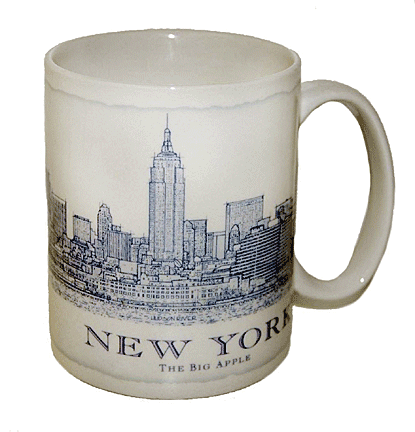 Starbucks
City Coffee Mugs are not just your ordinary coffee cups. These
limited-edition collectibles showcase beautiful designs inspired by
iconic landmarks and vibrant cityscapes from around the world. Each mug
is a piece of art, capturing the essence of a city and its unique charm.
From the bustling streets of New York City to the serene landscapes of
Kyoto, these mugs offer a chance to explore different cultures and bring
a piece of the world to your morning coffee routine. Starbucks
City Coffee Mugs are not just your ordinary coffee cups. These
limited-edition collectibles showcase beautiful designs inspired by
iconic landmarks and vibrant cityscapes from around the world. Each mug
is a piece of art, capturing the essence of a city and its unique charm.
From the bustling streets of New York City to the serene landscapes of
Kyoto, these mugs offer a chance to explore different cultures and bring
a piece of the world to your morning coffee routine.
Because Starbucks limits the number of all these mugs, collectors must
hustle to obtain the latest ones once they appear in Starbucks
locations. As new designs are released periodically, collectors must be
quick to get their hands on these limited-edition treasures. The
excitement of hunting down a particular mug or completing a series
becomes an addictive pursuit, making each addition to your collection a
rewarding experience.
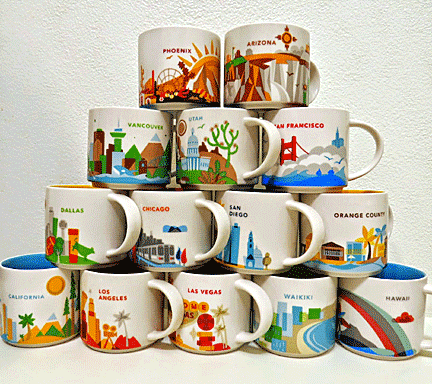 The
joy of discovering hidden gems. Some mugs may be rarer than others,
making the hunt even more thrilling. Imagine stumbling upon a
long-sought-after design or finding a rare, discontinued mug at a local
thrift store – the feeling of triumph is simply unbeatable! Plus, with
the ever-growing popularity of the Starbucks City Coffee Mug series, you
never know when a new favorite design will be unveiled. The
joy of discovering hidden gems. Some mugs may be rarer than others,
making the hunt even more thrilling. Imagine stumbling upon a
long-sought-after design or finding a rare, discontinued mug at a local
thrift store – the feeling of triumph is simply unbeatable! Plus, with
the ever-growing popularity of the Starbucks City Coffee Mug series, you
never know when a new favorite design will be unveiled.
Another thing that collectors of Starbucks mugs like is the social
collection and interaction with fellow enthusiasts. Sharing your
collection on social media, joining online forums, and participating in
swap events are all fantastic ways to bond with other collectors.
The Sky’s the Limit
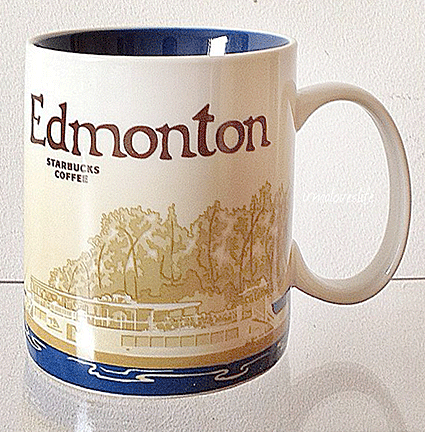 With
the demand for Starbucks mugs rising among collectors, their price has
also been on the rise. Today, the most valuable Starbuck mugs can sell
for up to $2,000 on the lower end and as high as $12,000 for the most
valuable mug featuring Edmonton, Alberta, Canada.. Designed and produced
in 2009, this 16-ounce mug has a blue inside and a white outside that
combined interesting pictures and its name. Since the sale of this mug,
the price of other Edmonton mugs have fallen to around $50. With
the demand for Starbucks mugs rising among collectors, their price has
also been on the rise. Today, the most valuable Starbuck mugs can sell
for up to $2,000 on the lower end and as high as $12,000 for the most
valuable mug featuring Edmonton, Alberta, Canada.. Designed and produced
in 2009, this 16-ounce mug has a blue inside and a white outside that
combined interesting pictures and its name. Since the sale of this mug,
the price of other Edmonton mugs have fallen to around $50.
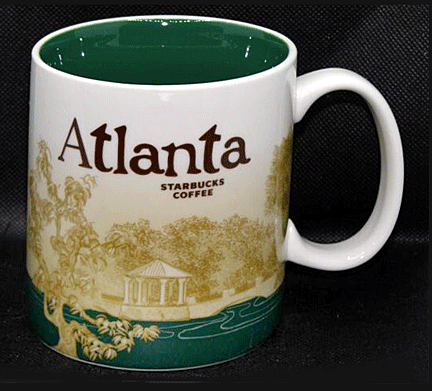 The
price of Charlotte, North Carolina, mug follows the Edmonton mug as the
second most expensive at $5,661. The Geography Japan set, consisting of
nine mugs, each representing a major city in Japan, including Osaka,
Nagoya, Fukuoka, Kyoto, and Tokyo, is in third place, selling at $5,000. The
price of Charlotte, North Carolina, mug follows the Edmonton mug as the
second most expensive at $5,661. The Geography Japan set, consisting of
nine mugs, each representing a major city in Japan, including Osaka,
Nagoya, Fukuoka, Kyoto, and Tokyo, is in third place, selling at $5,000.
While there are a few mugs that sell for stratospheric prices, most fall
into the $25 to $60 range on eBay. Some, like one from Atlanta, Georgia,
has a listing for only $8.50.
Most Global Icon series mugs now sell for an average of $25 each on
eBay. You Are Here and Been There series mugs sell for about the same.
But demand can change things.
Why Such High Prices?
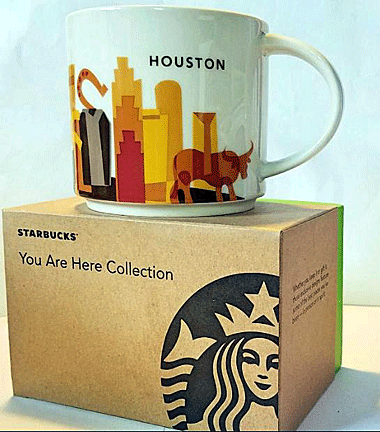 The
demand for all things Starbucks has been on the rise. Demand for mugs
has been growing significantly since the March of 2020, and as demand
for them grows, so do prices. When Starbucks discontinues a mug series,
the prices naturally skyrocket. This means the supply will keep going
down while the demand continues to rise. The
demand for all things Starbucks has been on the rise. Demand for mugs
has been growing significantly since the March of 2020, and as demand
for them grows, so do prices. When Starbucks discontinues a mug series,
the prices naturally skyrocket. This means the supply will keep going
down while the demand continues to rise.
Some Starbucks mugs are extremely rare. Being ceramic, they’re prone to
breakage, so added to their limited editions is the ever-present
possibility of them being destroyed. So finding an original Starbucks
coffee mug can be challenging.
Another reason for both the high retail prices of these mugs, as well as
those on the collector’s market, is that everything at Starbucks is
expensive. So people who purchase their products have enough extra funds
to also spend on the chain’s merchandise.
Lastly, collectors of Starbuck’s mugs tend to collect only those mugs,
and with Starbucks as the sole supplier, the company controls the market
for them.
< Back
to Collectibles Archives
Next Article >
|
